|
|
The
Self behind the Paint and the Canvas
by
Swami Jnaneshvara Bharati
SwamiJ.com
|
The
ancients used the metaphor of a painting on a Canvas, as a map to describe
how we may return to the direct experience of our True Self.
Our true
Self is just behind the Canvas, on which we paint countless false
identities. Following is
a pictorial description of this symbolism. Remembering the Canvas is a very
practical tool for Yoga Meditation and Meditation in action.
|
|
|
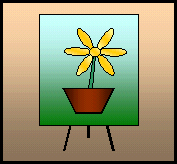
Our true
Self is just behind the canvas, on which we paint countless false
identities.
|
Index
Imagine
a blank Canvas
Then sketch an outline
Then play with the form and colors
Then we forget
Where is the real Meditation?
Starting to look inward
First, look for the Canvas
1st step of finding the Canvas
2nd step of finding the Canvas
3rd step of finding the Canvas
Remember the Canvas!!!
Intuiting behind the Canvas
Truth is the source of the Canvas
Truth is behind the Canvas
Truth is also in the Painting
|
|
top |
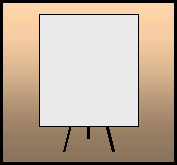 |
Imagine
a blank Canvas
Imagine a Canvas, on which there is no painting yet. When the
Oneness starts to manifest, first there is a Canvas. Everything
else grows outward from that. In
Sanskrit, the name of this primal level of manifestation is "Kutasta".
It comes from the root word "Kuta," which is an anvil.
It is on the anvil called Kuta that the blacksmith fabricates the
creation.
|
| |
top |
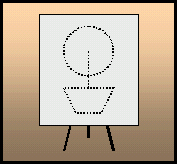 |
Then
sketch an outline
Before applying the paint, the artist will sketch an outline
on the Canvas, such as can be done by using a pencil. It gives
shape to what will come. In
the human, this is like our deep predispositions that lie latent
in the basement of the mind. (More
info; use browser "Back" to return)
|
| |
top |
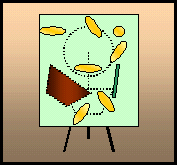 |
Then
play with the form and colors
The artist does not go directly from sketch to finished
painting. Rather, there is a process of outlining in light colors,
forming shapes, and starting to fill in the sketch. In
the human makeup, there is a vast unconscious process between the
root predispositions and our external expressions through body and
personality. This inner process is going on at all time while we
are awake and is the dominant mental process during dreaming
sleep. (More
info; use browser "Back" to return)
|
|
top |
 |
Then
we forget
The finished painting, enjoyed in all its beauty, is a result
of the Canvas, the pencil sketches, and all of the layers of
intermediate colors, outlines, and preliminary colors. All of
those are still there, on the Canvas, underneath the final
painting. Yet, when
looking a painting, pretty or ugly, we forget the undercoats of
paint, we forget the pencil sketches, and we forget the
Canvas. In the same
way, we forget the layers of ourselves, and our True Nature, as we
engage in the external actions of the world.
(More
info; use browser "Back" to return)
|
| |
top |
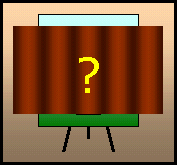 |
Where
is the real Meditation?
Once the painting is done, and we are living life, there
sometimes comes a call to search for more, and we encounter, learn
and begin to practice Meditation. It
is common that a student of Yoga Meditation learns to work with
lifestyle, stilling the body, allowing the breath to be smooth, and quieting
the conscious mind, but still not experience the depths of
Meditation. What
often has happened, is that we closed a curtain over all of that
troublesome stuff of the mind, but then we wonder why we are not
progressing in Meditation. We sit "outside" waiting for
Truth, Grace, God, Guru to come, and nothing happens. For years,
decades, we can sit relatively still and quiet, after having done
the lifestyle preparation for spiritual pursuits. We
end up either thinking that this stillness alone is the end of
Meditation, or we quietly wonder, "What's wrong with me?
Where is the real Meditation?"
|
| |
top |
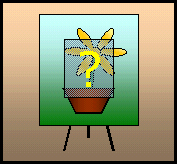 |
Starting
to look inward
Gradually we start to look at the painting that we, ourselves
have created. We turn inward, as if trying to find an inner window
that leads to Truth. We
come to see the error of creating and closing that curtain over
the conscious and unconscious mind. There
are really only two directions to look, either away from the
painting, or into the painting. We try our best to attain
happiness and joy by turning away from the painting, or even to
find God "out there". Ultimately,
it seems, we are forced back to the easel where we have set our
painting.
|
| |
top |
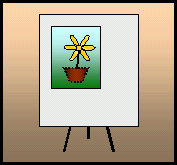 |
First,
look for the Canvas
Before looking for Truth itself,
we first look for the Canvas, though we may not be aware this is what we are
looking for at the time. In
finding the Canvas, we see the elegant way in which we have
painted our own lives on the Canvas, starting with the pencil marks,
then playing with the colors and forms, and finally bringing forth
the reality we call "me" in relation to "the
world". To find
the Canvas is not a matter of eliminating the painting, the
creative process underneath, or the pencil marks of samskaras.
Rather, we come to see the Canvas underneath the painting,
where it has been all along. This
is a real key to Yoga Meditation. We must be aware of, seek, and
find
the Canvas, which is beyond all of the activity of the conscious
mind and the gross world, and also behind, underneath, or the
screen for the projection of all of the unconscious, subtle,
psychic, or astral action of the universe. However,
we can never find the Canvas, or Truth beyond, by trying to turn
away from the painting. We must turn inward, squarely
facing the painting, so as to find the Canvas. How
do we go about looking for the Canvas?
|
|
top |
 |
1st
step of finding the Canvas
First, we deal with the external reality of which we are a
part and which we have created. In
Yoga Meditation, it means accepting the process of the conscious
mind,
rather than suppressing it. It means taking on an attitude of
being an explorer, an interior researcher. We are on a quest to
uncover that which is underneath the painting we have
created. It is not
that there is anything "wrong" with, or "bad"
about our painting. Rather, what we are looking for is underneath
the picture; whether we think our painting is a pretty picture or
an ugly picture. This
is a gentle process, not an invasive way of rooting out our
unconscious. By being aware of the fact that we are trying to
systematically go through the layers of the painting to the
Canvas, the process can unfold at a proper, healthy rate. The
important thing is that we are intentionally turning into the
painting itself, not putting a curtain over it. (More
info about the surface layer of the painting, the conscious
process of mind that experiences the external world; use browser "Back" to return)
|
| |
top |
 |
2nd
step of finding the Canvas
Gradually, we come to experience the
unconscious
mind, that
which is normally experienced only in dreaming sleep. Here,
we really learn the importance of cultivating the practice of
one-pointedness of the mind, and its companion, non-attachment, as
we learn to not get entangled in the stuff of the unconscious mind
or the subtle realm. We
come to see the process by which our finished painting came into
being. This journey can be a little bumpy, as we see, in retrospect,
how some of those turns we took in the road of life were not so
useful. However, we
continue on, since we are looking for the Canvas. (More
info about the unconscious process that is the active process
of creating the painting itself; use browser "Back" to return)
|
|
top |
 |
3rd
step of finding the Canvas
As attention moves past the gross
world and past the
unconscious process, we come to the deep grooves of the
unconscious, the sketches on the Canvas. These
are the samskaras, the driving force of karma, in their latent
form. Ironically, as we move past all of the colors and forms
moving around in the creative process, we come to a sort of
stillness when we see the sketches of the painting in their
initial form. In this process, the samskaras, the
sketches
weaken. There
is little pain here and little pleasure in the external sense;
just a quiet sense of "peace of mind," as the
"mind" has come to rest in coming to the level of
sketching. (More
info on the nature of the sketches on the Canvas; use browser "Back" to return) |
|
top |
 |
Remember
the Canvas!!!
With stillness, we find the Canvas
on which the three parts
have been drawn (sketch, process, and painting). From
the very beginning of Yoga Meditation, this is one of the most
important things to remember--the Canvas. In remembering the
Canvas, we do not suppress thoughts, emotions, images,
impressions, or sensations during Meditation. It
is truly possible for one to remember the Canvas on which all of
the dramas of our lives are playing out. Anybody can practice
remembering the Canvas; it is not some technically difficult
practice, though it is profoundly useful for one inspired to do
it. Sadly, few do so. Remembering
the Canvas does not mean that our challenges of life, mind and
emotions suddenly disappear. No, they are still there, while we
cultivate an ever increasing awareness of the
Canvas that exists underneath. While
we are "remembering" the Canvas, gradually the impact of
the dramas in the painting become weaker, as they play themselves
out externally and internally.
|
|
top |
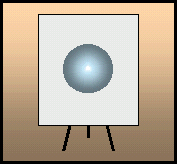 |
Intuiting
Behind the Canvas
While it is essential to find the Canvas, we sense that there is
something more, beyond even the Canvas, on the other side of
it. We may not see the
other side of the Canvas, but we wonder, "Where did this Canvas
come from? Knowing the Canvas is peaceful, still, silent, but there
is something more -- What is that?" With
patience, practice, and persistence in a spirit of passive volition,
we come to see through the window in the Canvas to get a glimpse of
the Truth that is on the other side.
|
|
top |
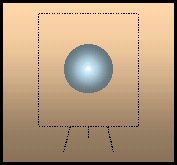 |
Truth
is the source of the Canvas
We come to see that the Canvas itself is the product of
Truth. The Canvas
manifested out of pure Consciousness for the sole purpose of
creating a field or playground. It manifested this field so that one can
play by painting their art, including each of the sequential stages of sketching, filling in, and
having the finished painting.
(More
info on the source that is behind the Canvas; use browser "Back" to return)
|
|
top |
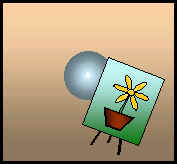 |
Truth
is Behind the Canvas
In seeing That, we come to see in direct experience that the
Truth we were seeking is behind all of the other layers:
- Truth is behind our
external world and conscious thoughts.
- Truth is behind our
unconscious process and the subtle realm.
- Truth is behind the
sketch marks of our samskaras that form our individuality.
- Truth is behind even the
Canvas of creation or manifestation itself.
However, we also come to see that
the only way to get to the Truth behind the painting is to go
through all the layers of the painting, so that we can first find the
Canvas.
|
|
top |
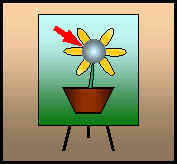 |
Truth
is also in the painting
The more we notice the Canvas, the more we notice
that the Truth is hiding right in the middle of
life. This
metaphor of the Canvas is a very practical tool in daily life. While
enjoying the paintings of life, we can be ever mindful of the Canvas
on which our mental, emotional and perceptual processes are playing
out. The more we
remember the Canvas, the more easily we remember the Truth behind
it. At the time of
seated Yoga Meditation, we intentionally look for the Canvas behind all
the stuff of the mind, not suppressing the thought processes. We are
trying to allow the object on which we are meditating to lead us
back to the Canvas, and to the Truth beyond.
top
|
-------
This site is devoted to
presenting the ancient Self-Realization path of
the Tradition of the Himalayan masters
in simple, understandable and beneficial ways, while not compromising
quality or depth. The goal of our sadhana or practices is the highest
Joy that comes from the Realization in direct experience of the
center of consciousness, the Self, the Atman or Purusha, which is
one and the same with the Absolute Reality.
This Self-Realization comes through Yoga meditation of the Yoga
Sutras, the contemplative insight of Advaita Vedanta, and the
intense devotion of Samaya Sri Vidya Tantra, the three of which
complement one another like fingers on a hand.
We employ the classical approaches of Raja, Jnana, Karma, and Bhakti
Yoga, as well as Hatha, Kriya, Kundalini, Laya, Mantra, Nada, Siddha,
and Tantra Yoga. Meditation, contemplation, mantra and prayer
finally converge into a unified force directed towards the final
stage, piercing the pearl of wisdom called bindu, leading to the
Absolute.
|
|